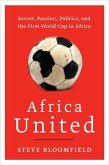Despite some difficulties in compiling enough data to fully evaluate the green performance of the FIFA World Cup, this report highlights many specific examples of success, energy-efficient intelligent lighting in Moses Mabhida Stadium in Durban, streetlights with low-energy bulbs and traffic lights with LEDs in Cape Town, and a 94-kilometre Bus Rapid Transport network in Johannesburg being a few of them. Based on its findings, this report drew key conclusions for South Africa that could help ensure a long-lasting environmental legacy from the World Cup, such as implementing renewable energy demonstration projects, improved transport system, energy efficiency, implementing proper waste segregation programmes, and water conservation. It also made a raft of recommendations for improving the greening of future large sporting events, such as the 2014 World Cup in Brazil.
Hinweis: Dieser Artikel kann nur an eine deutsche Lieferadresse ausgeliefert werden.
Hinweis: Dieser Artikel kann nur an eine deutsche Lieferadresse ausgeliefert werden.








